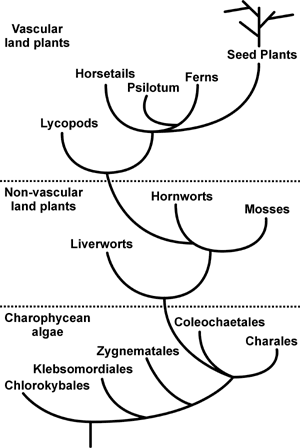 |
 |
|
Collaborators: Tadashi Ishii (Forestry Products Institute, Ibaraki, Japan) and Toshiro Matsunaga (National Agricultural Research Center, Kumamoto, Japan). |
| The appearance of land plants ~490 million years ago was a major event in the history of life on earth. The resulting reduction in the amounts of atmospheric carbon dioxide set the stage for the evolution of other terrestrial organisms. The relationships among the major lineages of land plants and the Charophycean algae have been investigated using comaprative morphology and gene sequence data (see image). Nevertheless, many question remain to be resolved. Further information on the evolutionary relationships of land plants can obtained here and in the links section. We have initiated projects to determine if the predominant pectic and hemicellulosic polysaccharides of flowering plant walls are also present in the walls of seedless vascular and non-vascular plants. These initial studies will focus on the occurence and structures of RG-II and Xyloglucan in the major lineages of the pteridophytes (ferns, horsetails, lycopods, and whisk ferns) and bryophytes (mosses, liverworts, and hornworts). In future studies we will also use immunocytochemical methods to investigate if changes in wall composition and structure occurred during the transition from aquatic to terrestrial plants and during the transition from non-vascular to vascular plants. |
 |
| Selected references Graham (1993) Origin of Land Plants. John Wiley, New York. Qiu and Palmer (1999) Phylogeny of early land plants: insights from genes and genomes. Trends Plant Sci., 4, 26-30. Niklas (2000) The evolution of plant body plans - a biomechanical perspective. Annals Bot., 85, 411-438. Friedman and Cook (2000) The origin and early evolution of trachieds in vascular plants: integration of paleobotanical and neobotanical data. Proc Royal Soc London Ser B, 355, 857-868. Popper et al (2001) 3-O-methyl-D-galactose residues in lycophyte cell walls. Phytochemistry, 57, 711-719. Pryer et al., (2001) Horsetails and ferns are a monophyletic group and the closest living relatives to seed plants. Nature (London), 409, 618-622. Karol et al (2001) The closest living relatives of land plants. Science, 294, 2351-2353. Willis and McElwain (2002) The Evolution of Plants. Oxford University Press, Oxford, England. Pryer et al (2002) Deciding among green plants for whole genome studies. Trends in Plant Sci., 7, 550-554. |